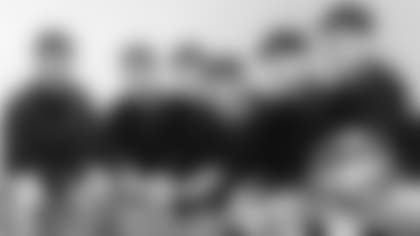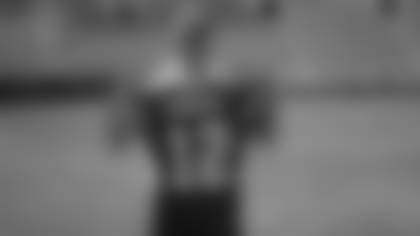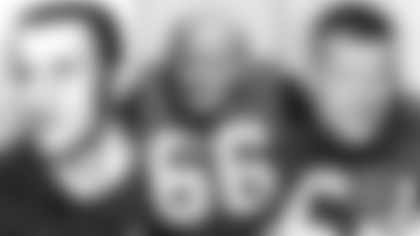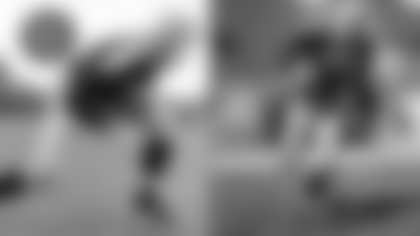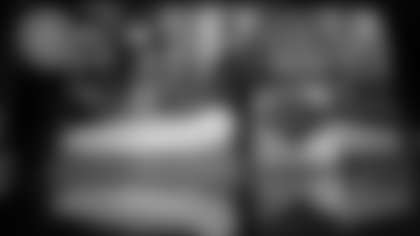Cliff Christl started gathering oral histories with former Packers and others associated with the team in1996 and will continue to gather them as Packers historian. Excerpts from those interviews will be periodically posted at www.packers.com
Bill Austin served as Vince Lombardi's offensive line coach with the Packers from 1959-64 after playing guard for him with the New York Giants. Drafted in the 13th round of the 1949 NFL Draft, Austin played two years for the Giants and then entered the Army. He returned in 1953 and played through 1957. Austin played under Steve Owen, a Pro Football Hall of Fame coach, his first three years and then for Jim Lee Howell his last four when Lombardi was offensive backfield coach. After spending the 1965 season as offensive line coach for the Los Angeles Rams, Austin was named head coach of Pittsburgh in 1966. In three seasons with the Steelers, Austin was 11-28-3. In 1969, Austin rejoined Lombardi as offensive line coach at Washington. A year later, Austin was named interim coach when Lombardi was diagnosed with cancer and compiled a 6-8 record. From 1971-77 and again from 1979-85, Austin served as an assistant coach for five different NFL teams and also for one in the United States Football League.
On how he became offensive line coach under Lombardi at age 30: "I had a pretty good relationship with Lombardi when he was coaching in New York. I was a small guy for a guard, maybe 218 pounds, and always went full speed, and he liked people like that. Evidently, he thought I had the ability to teach."
On how he got his start in coaching: "I wanted to be a coach after (playing for seven years). While I was playing in New York, Jim Lee Howell was our tight end coach (prior to 1954). We'd practice in the morning and Jim Lee Howell was the head coach of (Wagner College). We drove over, got on the ferry and got over to (Staten) Island, and I was his line coach. It kept me off the streets and I got a couple extra dollars. That's how I got into the coaching. I enjoyed it and coached at the University of Wichita as line coach in 1958. Then went with Vince to Green Bay."
On whether he applied for the job or was contacted by Lombardi: "No, he contacted me."
On what his impressions were of the 1-10-1 Packers, who had nine future Pro Football Hall of Famers on their 35-man roster: "I think they were a bunch of undisciplined players at that particular time and the goal was to get some discipline. We had some good personnel and we wanted (them to develop) a good attitude that they could win. The talent was there. Jimmy Taylor was in his second year. (Paul) Hornung. The tight ends, whether it was the Michigan guy (Ron Kramer) or (Gary) Knafelc. And the two guards were there. We just had to have more discipline."
On Lombardi's first training camp: "As a player, I had been through a number of years with Lombardi when he was an assistant coach. Of course, he ran the offense with the Giants. I didn't think the training camp was that tough. We had to find out what each player could do. And in Lombardi's own way, he put the pressure on them to perform. And if you couldn't perform, you were gone."
On Lombardi's methods to test how players reacted to pressure: "He was no different in training camp than in league play. But I believe he liked to put pressure on them and see if the player cracked. He'd put the pressure on them in practice."
On Lombardi's installing his offense that first year: "When he'd get that chalk in his hand and started putting diagrams on the blackboard, you better remember what he wrote up there if you were a player. He just came across a little stronger than most people I coached with. He wanted everybody to know the general idea of the play and where the key blocks were. He always put the whole picture on the board when he put in a new play in training camp: Here's why we're going to do this, do that."
On whether Lombardi installing his famed power sweep was a complicated process in 1959: "I didn't think so because I was an offensive guard who played for him when he was offensive (backfield coach) with the New York Giants. So I ran those Fuzzy Thurston and Jerry Kramer blocking patterns. (Lombardi) would break a few pieces of chalk at the board. But that was the way he coached."
On whether it took time for Lombardi to get his message across to the players about the importance of the power sweep or what he called his signature play: "No, he could do that quickly. There were a couple (key) blocks. The No. 1 block was the near back – in the case of the power sweep, the fullback Jimmy Taylor – blocking the defensive end with a certain technique. Then the two guards, Fuzzy Thurston and Jerry Kramer, coming around and leading the ball carrier around the corner. There was no particular key to it. If you saw a guy standing there, you knocked him down. But the key block was the near back. The two backs were split and each was lined up behind the tackle, the halfback was the ball carrier and the near back the lead blocker. And if the near back doesn't get his block, the play doesn't go."
On whether Lombardi would address the play for hours in meetings based on John Madden's stories about how long Lombardi could talk about the power sweep at clinics: "No. When coaches talk to other coaches, they extend their talk. The play wasn't that hard to do."
On Lombardi's first game in 1959, a 9-6 victory over the Chicago Bears: "We were not a top offensive team yet, but we played very good defense."
On the alignment for Lombardi's power sweep: "Each back was equal distance to the outside of the quarterback, probably straddling the inside leg of the two tackles. The fullback was to the strong side and the halfback to the weak side. The halfback carried on the power sweep. It could be run back to the weak side with the fullback, but 90 percent of the sweeps the halfback carried."
(Note: In Lombardi's offense, the power sweep was usually run to the right off the tight end's block and the play call was Red Right 49. The Packers also ran the power sweep to the left with the tight end to the left side, but less frequently. Whether the Packers ran the power sweep to the right or left, the halfback always carried the ball. The play call for the power sweep to the left was Red Left 48. Actually, the call was Red Left 28 when Lombardi installed his offense in his first training camp in 1959. At the time, he was planning to run a three-back offense. But then just after the halfway mark of his first season, Lombardi switched to a three-end offense and eventually renumbered the backs. That was when it became 48. The power sweep, Red 49 or Red 48 (or 28), as one would expect, was run to the strong side of the formation, the side where the tight end and fullback were key blockers. Because the Packers ran a predominantly right-handed offense, Red Right 49 was what Lombardi considered his lead play. "The opposition must stop it if they are to stop us," was how he put it. The weak-side sweep with the fullback carrying was one of many plays, running and passing, that the Packers used to exploit defenses when they overplayed the power sweep. But it wasn't a staple of the offense because it required a split receiver to move inside to the tight end position and become a key blocker.)
On Ron Kramer's contribution as the tight end or point-of-attack blocker on the power sweep: "He was like another tackle on the field. On the sweep, he would take the linebacker whichever way the linebacker wanted to go. Then the runner would key off of his block. He didn't have to bull the guy. But Ron Kramer was a tackle-like tight end. He weighed 250, I guess. And he was a fine athlete."
On the alignment of the tight end in Lombardi's offense: "On the split backs, which we ran the Green Bay sweep out of, the tight end would be opened up anywhere from six to nine feet. If we were in the brown formation, we had a fullback and a halfback, with a tight end on the right side. But, then, the tight end would be within two or three feet of the tackle."
On whether the blocking was the same when Knafelc, a converted split end, was the tight end in 1959 and 1960: "No, same way. See the tight end didn't have to bull-block anybody. Here comes the runner, here comes two guards. You (tight end) stand up and get in the linebacker's face. And the linebacker has to make a decision, whether he's going to go outside and make the play cut back. If he does that, we run inside. The tight end helped him go whichever way he wanted to go, as long as he didn't get across the line of scrimmage."
On other key blocks on the power sweep: "Always a key block on the sweep was the on-side tackle either on a down-block on the man over the guard or – if we were running to the right side – the right tackle would slam the defensive end with the right shoulder and then look inside for the middle linebacker. The fullback usually blocked the defensive end. If the defensive end was real tight, the tackle – we had calls for this – would hook the defensive end and the back, Jimmy (Taylor), would go through on the outside of him and look to the inside for the middle linebacker."
On the adjustments if the tackle had to block the defensive tackle: "That would be a down block and the fullback would have (to block) the defensive end, and the tight end had the (outside) linebacker. The front-side guard – if you want to name him, probably Jerry Kramer – would pick up the force man. If the (flanker) wasn't split too far, the offside guard, Fuzzy, would pull behind (Jerry Kramer) and look to the inside."
On the adjustments if the tackle blocked the defensive end and someone else had to block the defensive tackle: "The center came on-side if they were in a 4-3 to pick up the man over the guard. Those were calls made at the line of scrimmage. The center made the call."
On Taylor's best play and the emphasis on the fullback running to the weak side: "From the brown formation – that was the fullback at home (behind the quarterback) with the tight end on the right side and the split end on the left side – that would have been Brown Right 36: the three-back to the six-hole. Taylor would go around the key block: the left tackle on the defensive end."
On the halfback option and whether it was basically the same play as the power sweep: "Yes. We ran that play with the New York Giants."
On other effective running plays from the split-back formation: "We had an inside trap, a long trap on the defensive end, because that fit in with the sweep. The halfback usually carried on the trap and only the right guard pulled. Occasionally, we ran the fullback or the halfback up the middle just to keep them honest."
On Paul Hornung's effectiveness around the goal line: "He just had a desire to get in. He got some pretty good blocking down there usually, but he could carry a guy into the end zone. He was just a hard-nosed player."
On his role in the power sweep when he played for Lombardi in New York: "I was the pulling guard. The Giants always played with a tight end. (Bob) Schnelker was the tight end."
On the importance of speed when Lombardi was looking for offensive linemen: "Lombardi didn't spend too much time on 40-yard sprints and things like that. We'd have some races. (Bob) Skoronski and (Forrest) Gregg could beat Norm Masters. But Norm Masters was still a fine football player. We had three good tackles."
On Skoronski and Masters sharing the left tackle position for a good share of Lombardi's first six seasons: "I would say they were similar-type players. Masters could play some guard, too. They were just good football players. Straight ahead, probably Masters. Pass blocking, Skoronski probably was above (Masters). He had a little quicker feet. Masters was probably a little stronger."
On moving Skoronski to center for the first half of the 1964 season and then moving him back to tackle: "Skoronski was playing center and we're going over to Minnesota. After practice on Thursday, Vince called me in the office and said, 'I want you to make a switch. We're going to put (Ken) Bowman at center and everybody else goes back to their spots.' We had a couple injuries."
On leaving Lombardi's staff in 1965 to become an assistant coach with the then lowly Los Angeles Rams: "Sometimes you get a bug up your rear-end and get tired of hearing a guy holler. So I left and went to coach with the Rams for a couple years and became a head coach after that. But Lombardi was a great individual, smart football man, simple football man."
Austin died in 2013 at age 84. The excerpts above were taken from interviews conducted in 2007 and 2009.



